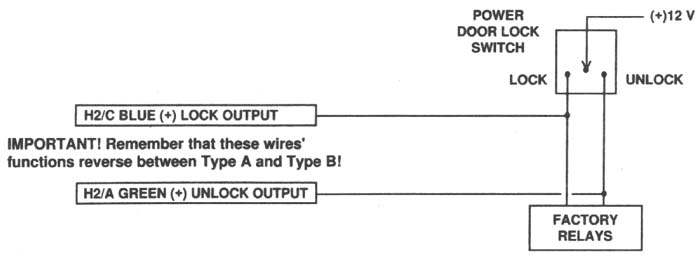Thanks for the help and link...
I have access to the DirectTechs website with a Clifford Dealer password. I still don't get it, something isn't making sense. Is that diagram showing the factory lock relays or are they supposed to be 2 aftermarket installed relays?
This system has a single 451M relay already hardwired into the alarm system. (see my first post, 3 outputs from brain to 451M, then 5 outputs from 451M) I'm assuming since it is a quality system they give you that added bonus, the 451M, which eliminates the need for installing 2 aftermarket relays. (not all the models come with the 451M) But as you said Mark, I might not need it.
The info I have on my system from the DirectTech site is on another website I found that somebody converted to HTML...
================================

IMPORTANT! The door lock outputs are low current and should not be attached directly to any high current device; they are only to be used to activate relays.
This system can control two common power door lock types without any additional parts! With certain vehicles, or if an actuator is to be installed, either a 451 M Door Lock Relay Satellite or two relays will be required.
IMPORTANT! If you mistake a Type C direct-wired system for a Type A positive-pulse system, the module will be damaged! ===(Insert footnote from Skybax... "WE DON'T WANT THAT TO HAPPEN NOW DO WE"  )===
)===
Type A - (+) 12V pulses from the switch to the factory relays
The system can control this type of system directly, with no additional parts. The switch will have three wires on it, and one will test (+) 12V constantly. The others will alternately pulse (+) 12V when the switch is pressed to the lock or unlock position.
If you cannot get to the switch, and you find a set of wires that pulse (+) 12V alternately on lock and unlock, you must take care to ensure that it is not a Type C direct-wire system.
Here is a test: Cut the wire which pulses (+) 12V on lock, and then operate the switch to unlock.
If all doors unlock, the vehicle uses type A system.
If you lose all door lock operation in both directions, you are operating the master switch in a Type C system.
If you lose all door lock operation of one or more, but not all motors stop operating, and other doors still work, you have cut a wire leading directly to one or more motors. You must instead find the actual wires leading to the switch.
Many domestically-made GM vehicles use Type A locks. However, many more GM vehicles are Type C than in previous years. The full-size pickups (1989-up), many of the S10 Blazers, the Corvette, '95 Cavalier/Sunfire 1993 - and newer, Camaro/Firebird all use Type C door locks, and cannot be controlled without a 451M! Almost all domestically-built Fords are Type C. Ford builds almost no Type A systems. Chrysler builds both Type A and Type C, so use care.

Type A - (-) pulses from the switch to the factory relays
This system is common in many Toyotas, Nissans, Hondas, and Saturns, as well as Fords with the keyless-entry system (some other Fords also use Type B).
The switch will have three wires on it, and one wire will test ground all the time. One wire will pulse (-) when the switch locks the doors, and the other wire will pulse (-) when the switch unlocks the doors. This type of system is difficult 1 mistake for any other type.

Type C - Reversing Polarity
Interfacing with a reversing polarity system requires either two relays or one 451 M (not included). It is critical to identify the proper wires and locate the master switch to interface properly. Locate wires that show voltage on lock and unlock. Cut one of the suspect wires and check operation of the locks from both switches. If one switch loses operation in both directions and the other switch operates in one direction only, you have located one of the target wires. The switch that lost all operation is the master switch. If one switch works both directions and the other switch works only one direction, you have a Type A system. If both switches still operate, but one or more doors have stopped responding entirely, you have cut a motor lead. Reconnect it and continue to test for another wire. Once both wires have been located and the master switch identified, cut both wires and interface as shown below

===================================
Either I'm getting old, or have a tired brain today (it IS sunday) but I can't seem to make sense of it.
------------------

Profile? In 20 years... Auto Detailing, Auto Body, Classic & Antique Restorations, Mechanic, Engine Performance Specialist, Porsche-Jaguar Tech, Wholesaler, Sales, Independent Full Service Repair Shop, Vehicle Vinyl Graphic Design and hard-core auto / aviation enthusiast... now searching for a new career. What a ride![This message has been edited by Skybax (edited 02-07-2005).]




















 )===
)===

